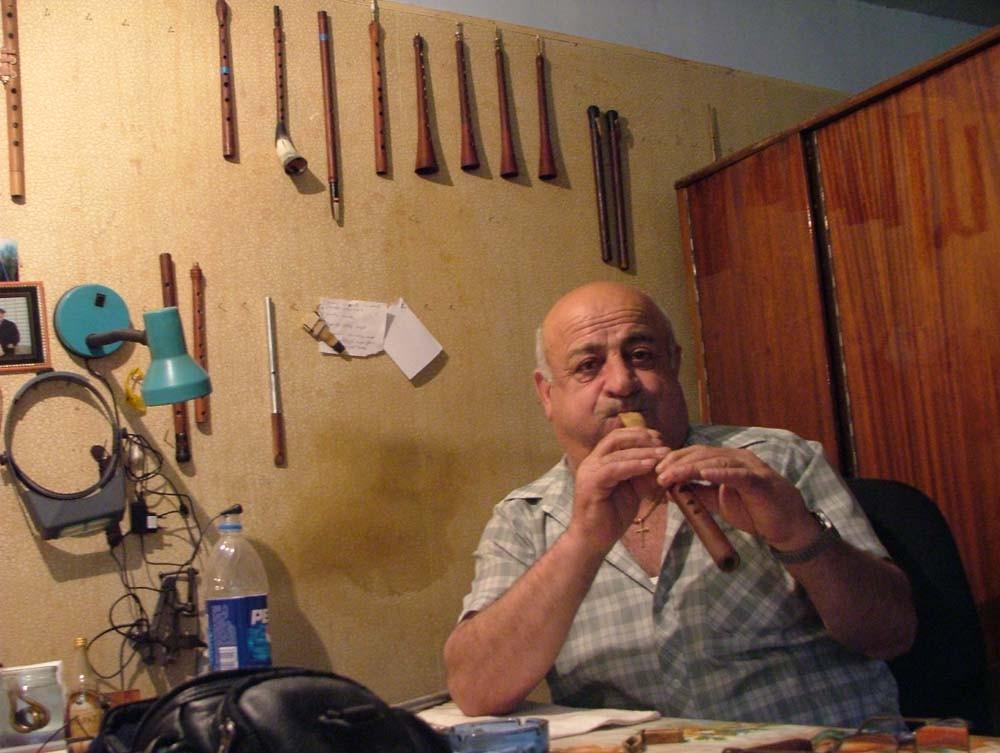
The Duduk: From Village Feasts to Hollywood Movies
Duduk is the only instrument that makes me cry
Aram Khachaturyan
How a duduk is made
Varpet (master) Rubik's day begins this way: with a cup of black coffee in front of him on the table and a cigarette in his hand, he leans back in his chair, closes his eyes and begins sketching the future instrument in his mind. But no, not every day starts like this; only those days when the varpet's muse visits him, because, he says, you must make the duduk only when you are in right mood to do so; otherwise the duduk will have no soul.
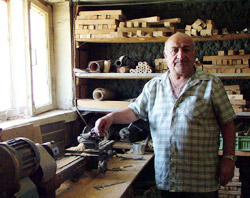 Varpet Rubik then tries the instruments once they are made; half of the duduk disappearing in his big hands, he brings the instrument to his mouth and a soft, slow melody fills his studio in basement floor.
Varpet Rubik then tries the instruments once they are made; half of the duduk disappearing in his big hands, he brings the instrument to his mouth and a soft, slow melody fills his studio in basement floor.
Now is the time to use the machines and the tools.
Varpet Rubik has been making duduks for 45 years and is self-taught. About 50 years ago he was playing a homemade shvi (flute) as he herded his family's cows in the fields of the Yerord Mas district. The musician Avetichyan saw him and invited him to play in the Yerord Mas Cultural House. The young cowherd agrees and whilst playing in the Cultural House became drawn to the duduk as well.
"At that time (the late 1950s)," Varpet Rubik remembers, "only two people in Armenia were making shvi, Harout from the Kond district and Tatos from Leninakan (Gyumri). They would make duduk by eye, and the musicians would have to tune the instrument themselves. Other less skilled people would try to make duduks and sell them in the bazaar. Very few people played the duduk. To find a good duduk was so difficult that great dudukist Vache Hovsepyan had a ghamish (reed) which he used for years; once it just cracked into pieces while he was playing.'
The young man, a mechanical engineer by specialization, decided to make his duduk himself. For years he tried many different woods with varying success. The results of his experiments are here in his studio, from the very first historical duduks up to contemporary instruments. The first duduks consisted of one part. They had nine holes, seven holes on the front and two holes on the back. Then the holes become ten; eight on the front and two on the back. Originally duduks were made of reed.
 'Reed is a water plant, says Varpet Roubik, so it is very vulnerable to humidity. When water gets into the plant its parameters change. Hence the sound also changes.'
'Reed is a water plant, says Varpet Roubik, so it is very vulnerable to humidity. When water gets into the plant its parameters change. Hence the sound also changes.'
This distortion was later eliminated: the bodies began to be made of wood and the sound producer, or ghamish, of reed. In Armenia the best or "right" duduks are made of apricot wood. The tree has to be old, around fifty or sixty.
'When a tree grows old its cells die; that is the appropriate tree for the duduk. That wood is very heavy, when it does not allow moisture to go further than the first layer and does not change its shape after it gets dry. The apricot tree has to be solid to get the beautiful timbre of the duduk sound.'
The distinguished soft timbre of the duduk is determined also by the rings on the section of the tree. Their number shows the age of the tree and the gaps between the circles show the quality of the tree. If the circles are far from each other it means the soil there is fertile, so the tree is very well fed and its density is high.
From this viewpoint, the best apricot grows in the village of Oshakan near Ashtarak, where there is clay soil and it is watered naturally, by rain.
 'The tree for duduks has to be cut parallel to its rings. Thus you will get the beautiful sound of the duduk. Otherwise the sound is sharp and loud. With that duduk you can play dance melodies.'
'The tree for duduks has to be cut parallel to its rings. Thus you will get the beautiful sound of the duduk. Otherwise the sound is sharp and loud. With that duduk you can play dance melodies.'
Once it is cut, the wood has to be put in a dark, not windy place to dry. The drying process lasts one to three years. Then the varpet cuts square pipes out of the wood, marks the centers, makes them round on the machine and drills the holes. He then prepares the edges where the ghamish will be placed and tunes the instrument with a matkhal tool. Then he makes the ghamish.
'The reed that the is ghamish made of is of two types - male and female. The female sort is soft and obedient like a woman and is the best for the ghamish . The best reed grows in Gyangia on the banks of the river Araks. Now we cannot get there, and so we use local reed from Ghamshlu or Kharabakh, which is not as good.
The reed has to be picked in late autumn when the plant goes to sleep. It needs to be dried as well. Then the reed, sound regulator, and cap are cut.
The modern duduk
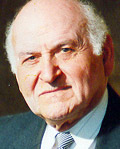 The range of the classical duduk is one octave. That of course limits the duduk's repertoire. The famous Duduk specialist in mugham, Georgi Minasov, has found the solution for that; he has lengthened the body of the duduk and added more holes to it. His improved duduk has fourteen holes-eight on the front, and six on the back. The holes on the reverse are closed with levers. Once the turner has made the duduk, Minasov's son Michael adds the levers.
The range of the classical duduk is one octave. That of course limits the duduk's repertoire. The famous Duduk specialist in mugham, Georgi Minasov, has found the solution for that; he has lengthened the body of the duduk and added more holes to it. His improved duduk has fourteen holes-eight on the front, and six on the back. The holes on the reverse are closed with levers. Once the turner has made the duduk, Minasov's son Michael adds the levers.
This improved duduk's range is one-and-a-half, two, or three octaves. This makes it possible to play gammas, mughams, and classical works which are impossible on a classical duduk.
Minasov not only improved the classical duduk, he also created several new instruments - bass, tenor and baritone duduks. Many Armenian duduk players do not accept Minasov's innovations.
'By adding levers to the duduk you can get an oboe or clarinet. We already have these instruments. Unlike them, the duduk has not developed technically, and this is very important; the duduk tells us something very old, it brings our ancestors' voice to us,' explains composer Vache Sharafian.
'The Duduk does not need to be made into a 'European' instrument. Even foreigners like its purity," says dudukist Gevorg Dabaghyan.
Georgi Minasov takes such views easily.
'The Clarinet had just five holes at the very beginning. The clarinet has now come a long way. Even the duduk has had two or three holes. Time goes by, everything develops, and the duduk also has to develop. It is hard to accept what is new. I believe that in the future my duduks will not be unusual and will be accepted as classical duduks are now.'
Where the duduk came from
It is claimed by dudukists, susuk makers and duduk fans that the duduk is the only instrument among those played in Armenia that has true Armenian origins. The other instruments came from Arabic countries and countries that once were on the Silk Road.
Traveling Armenians in their turn took the instrument along to Persia and the Balkan countries, Azerbaijan and the Middle East. Over the centuries the duduk has undergone some changes in those countries, mainly in the way of tuning and the number of holes. In Georgia, it is called the duduki, in Turkey the mei, in Azerbaijan the balaban, etc.
The most convincing proof that the duduk is pure Armenian is its sound, some say adherents to this view. The duduk expresses the Armenian spirit, history, past, present, and future. No instrument can tell of Armenians as sincerely and eloquently as the duduk.
"The duduk is both simple and complicated, like Nature," says Gevorg Dabaghyan. "It is a fragment born of dew, wind, and sun. It is natural and universal."
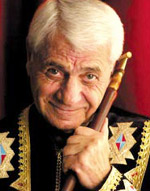 "The Americans and the Japanese have tried to reproduce the sound of the duduk on a synthesizer and have always failed. This means the duduk is given by God," believes Djivan Gasparyan.
"The Americans and the Japanese have tried to reproduce the sound of the duduk on a synthesizer and have always failed. This means the duduk is given by God," believes Djivan Gasparyan.
Maybe it is true; especially bearing in mind the fact that no one knows when the duduk was created. The legends around it are numerous.
Some claim that the duduk was born thousands of years BC and even before the ancient kingdom of Urartu. There are images in the miniatures of Matenadaran of people playing woodwinds. The Duduk is so Armenian by its nature that it can be assumed that the people are playing a duduk or an ancestor of the duduk.
Some go further, claiming that the duduk was played on Noah's Ark.
One of the versions says that at the very beginning the duduk was called the tsiranapogh . In the 1920s, Russians for whom that name was too complicated named it duduk, from Russian dudka.
In the 1990s a group of Armenian archeologists discovered a woodwind made of a stork's foot bone. The scientists claim that the instrument is an ancestor of the duduk.
Only God knows which is true and which is not in all this. But it is well known that the duduk we have now was made by Armenian musicologist Vardan Buni in the 1930s and is called a bunifon . That is the most common type of duduk now: its sound is particularly rich and famous all over the world.
Once the duduk was disregarded; parents would not marry their daughter to a dudukist.
The great Armenian dudukists Levon Madoyan and Margar Margaryan were the ones who brought the duduk greater acclaim and changed attitudes toward it.
In Armenia nowadays the duduk is played on the saddest and happiest of occasions, at funerals and weddings. During concerts, feasts and funerals there are always two dudukists playing; one is a soloist and another one is damchash . Dam means breathing, accompaniment, in eastern musicology, harmony of melodies. The creation of a background for the soloist is a damchash.
Duduk and the world
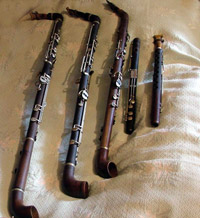 Today the duduk is one of the most popular instruments on Hollywood film soundtracks. The trend started in 1988 with The Last Temptation of Christ. The composer was Peter Gabriel; he used Vache Hovsepyan's duduk music in the film.
Today the duduk is one of the most popular instruments on Hollywood film soundtracks. The trend started in 1988 with The Last Temptation of Christ. The composer was Peter Gabriel; he used Vache Hovsepyan's duduk music in the film.
Then came Crow, Zena, Warrior Princess, and the Hulk. The duduk has been played in a variety of box-office hits, The Passion of the Christ, Gladiator, Alexander, Syriana, Munich, Evgeni Onegin, Ararat . The creators of the much-talked-of Da Vinci Code could not neglect using the duduk as well (played by Djivan Gasparyan).
The composer of The Passion of Christ, John Debney, compared the duduk to a human voice and called it a reflection to the past and distant countries.
Pedro Eustache, who played duduk in the movie, said, 'There are things that are beyond geography and time and the duduk is one of them.'
Eustache started learning the duduk in 1994 with Djivan Gasparyan, whom he met in Los Angeles. Before he played different woodwinds, but now the duduk prevails in his repertoire. It is not an exaggeration to say that Pedro Eustache's has played a huge role in spreading the Armenian duduk throughout the world.
Eustache has his favorite story connected to the duduk. In 2002 he played with Ravi Shankar at a concert dedicated to the memory of George Harrison in London. Shankar wrote a duduk solo for him.
After the concert, Paul McCartney asked Shankar to introduce him to that Indian musician who played that touching Indian instrument.
"The musician is from Venezuela," Shankar answered, "and the instrument is from Armenia." McCartney invited the musician to play duduk on his last album Chaos and Creation in Paradise , in the song Jennie Ran.
The sound of Djivan Gasparyan's duduk can be heard in Gladiator , Russia House, and over thirty other films "In 1982 Brian Eno and Peter Gabriel came to Moscow to listen to people's instruments from all fifteen Soviet republics,' Djivan Gasparyan says. "At that time, gramophone recordings were made only in Moscow at the All-Union Fund. Of the Armenian dudukists, only Vache Hovsepyan and I were recorded there. They liked my recording and sold it to the English. Thus I went to London to have a concert in the English church hall, which has now become an Armenian Church. Instead of the planned three concerts I played ten.'
In 1985 Djivan Gasparyan gave a solo concert in Armenia. That was reportedly the first-ever solo duduk concert; before that the duduk had only been played in orchestras.
Then came the invitations from Hollywood and recordings with the famous musicians like Lionel Richey, the Chronos quartet, Brian May, Sting, and others.
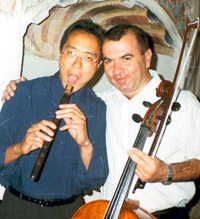 Nowadays, to have a duduk in a song or a film has become a necessity, never mind whether using the duduk is appropriate in the song or movie or not. Obviously what is popular is in danger of being lost.
Nowadays, to have a duduk in a song or a film has become a necessity, never mind whether using the duduk is appropriate in the song or movie or not. Obviously what is popular is in danger of being lost.
UNESCO has a program called Masterpieces of the Oral and Intangible Cultural Heritage of Humanity. Last year duduk music made it onto the list of masterpieces. Composer Vache Sharafian and dudukist Gevorg Dabaghyan (Ararat) worked on the program, which involves historical and scientific analyses, a film, and a web page. They are both involved in The Silk Road Project of cellist Yo Yo Ma, who has gathered musicians from the countries that were once on the Silk Road and organizes concerts with them all over the world.
The main goal of the UNESCO program is to show the Armenian duduk and its place in the Armenian soul and every day life.
"Different nations have different ways of playing the duduk. The sound of the Armenian duduk is unique, due to the technique of Armenian musicians,' Vache Sharafian says. 'The Armenian duduk is accepted by everybody because of its sincerity. It expresses our nation; it has great strength and longing in it. It has victory in it."
The Duduk and Armenia
Hopefully the program will contribute to increasing the duduk's popularity in Armenia as well. In Armenia, the duduk is more and more taken as a funeral instrument.
"The dudukists playing at funerals and the duduk sellers at the Vernissage are a real disaster for the duduk," Varpet Roubik says. "They distort the instrument and spoil the quality of the duduk."
Now I make duduks mainly for the foreigners, Armenians do not care much for the duduk, especially the youth, that dedicate themselves to western music.'
 The situation is not yet lost. Among the youth is Gayane, a student of Georgi Minasov, who has been in love with the duduk all her life and decided to learn it.
The situation is not yet lost. Among the youth is Gayane, a student of Georgi Minasov, who has been in love with the duduk all her life and decided to learn it.
The law student dreams of mixing the duduk with hip-hop and thus attracting more young people to the instrument.
There is also the 12-year-old student of Gevorg Dabaghyan, Haroutyun, who is a big fan of Vache Hovsepyan's music and dreams of moving people's heart with his duduk like Hovsepyan did.
At Yerevan State Conservatory they have duduk classes, but there is no duduk school in Armenia yet. Djivan Gasparyan intends to open one for orphans and street children. Of course, all those who wish to learn duduk can join the children.
 Videos
Videos Photos
Photos
Write a comment